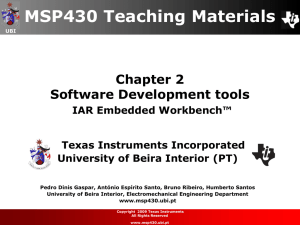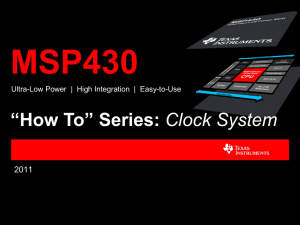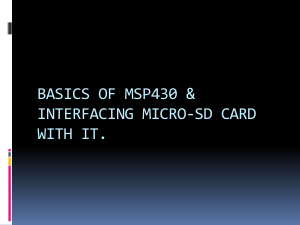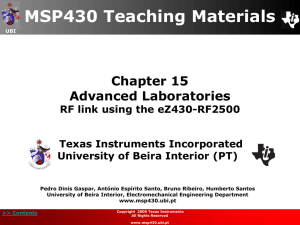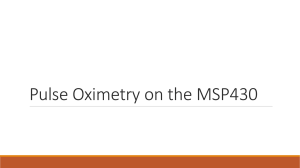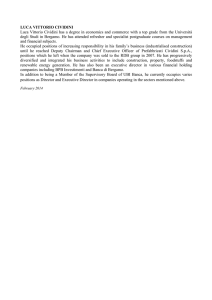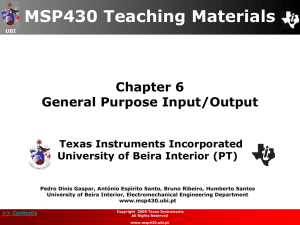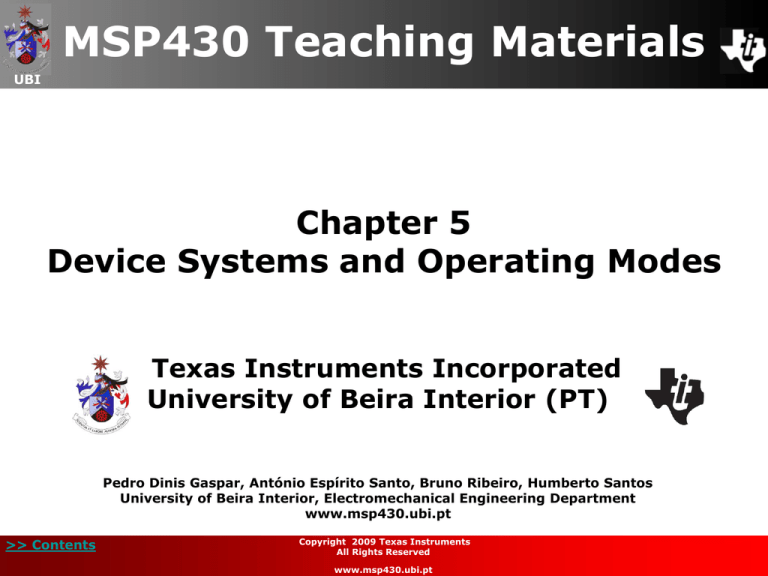
MSP430 Teaching Materials
UBI
Chapter 5
Device Systems and Operating Modes
Texas Instruments Incorporated
University of Beira Interior (PT)
Pedro Dinis Gaspar, António Espírito Santo, Bruno Ribeiro, Humberto Santos
University of Beira Interior, Electromechanical Engineering Department
www.msp430.ubi.pt
>> Contents
Copyright 2009 Texas Instruments
All Rights Reserved
www.msp430.ubi.pt
Contents
UBI
Introduction
Internal system resets
System clocks
Interrupt management
Watchdog Timer
Supervisory voltage system
Low-power operating modes
Quiz
>> Contents
Copyright 2009 Texas Instruments
All Rights Reserved
www.msp430.ubi.pt
2
Introduction
UBI
Description of the internal devices and systems of the
MSP430;
It includes descriptions of the:
Internal system reset;
Clock sources;
Interrupt management;
Low-power operating modes.
Quiz.
>> Contents
Copyright 2009 Texas Instruments
All Rights Reserved
www.msp430.ubi.pt
3
System reset (1/5)
UBI
The MSP430 families make use of two independent reset
signals:
Hardware reset signal - POR (Power On Reset);
Software reset signal – PUC (Power Up Clear).
Different events determine which one of the reset
signals is generated;
Sources that can generate a POR:
Initial device power up;
Low signal at the reset pin (RST/NMI) when this is
configured in reset mode;
Low signal at the supervisory voltage system (SVS) when
the register bit PORON is high.
>> Contents
Copyright 2009 Texas Instruments
All Rights Reserved
www.msp430.ubi.pt
4
System reset (2/5)
UBI
Sources that can generate a PUC:
Active POR signal;
Watchdog timer (WDT) expired when it is configured in
supervision mode;
Flash memory access control registers security key violation.
>> Contents
Copyright 2009 Texas Instruments
All Rights Reserved
www.msp430.ubi.pt
5
System reset (3/5)
UBI
Conditions:
Hardware reset signal (POR) is active then:
• SR is reset;
• PC is loaded with the address in location 0FFFEh;
• Peripheral registers all enter their power up state.
Software reset signal (PUC) is active then:
• SR is reset;
• PC is loaded with either the reset vector (0FFFEh), or the
PUC source interrupt vector;
• Only some peripheral registers are reset by PUC.
>> Contents
Copyright 2009 Texas Instruments
All Rights Reserved
www.msp430.ubi.pt
6
System reset (4/5)
UBI
All 2xx and 4xx MSP430 devices possess a reset circuit
by power source disturbance identified by Brown Out
Reset (BOR);
This circuit is an enhanced POR system:
Includes a hysteresis circuit;
Device stays in reset mode until voltage is higher than the
upper threshold (VB_IT+):
• BOR takes 2 msec to be inactive and allow the program
execution by CPU;
When voltage falls below the lower threshold (VB_IT-):
• BOR circuit will generate a reset signal;
• Suspends processor operation until the voltage rises up
above the lower threshold inferior value.
>> Contents
Copyright 2009 Texas Instruments
All Rights Reserved
www.msp430.ubi.pt
7
System reset (5/5)
UBI
Brownout timing:
>> Contents
Copyright 2009 Texas Instruments
All Rights Reserved
www.msp430.ubi.pt
8
System clocks (1/24)
UBI
Allows the CPU and peripherals to operate from different
clock sources;
The system clocks depend on the device in the MSP430
family:
MSP430x2xx:
• The Basic Clock Module+ (BCM+);
– One or two oscillators (depending on the device);
– Capable of working with external crystals or
resonators;
– Internal digitally controlled oscillator (DCO);
– Working frequency to up 16 MHz;
– Lower power consumption;
– Lower internal oscillator start-up time.
>> Contents
Copyright 2009 Texas Instruments
All Rights Reserved
www.msp430.ubi.pt
9
System clocks (2/24)
UBI
MSP430x2xx:
• Basic Clock+:
>> Contents
Copyright 2009 Texas Instruments
All Rights Reserved
www.msp430.ubi.pt
10
System clocks (3/24)
UBI
MSP430x4xx:
• Frequency Locked Loop (FLL+):
– One or two oscillators (depending on the device);
– Capable of working with external crystals or
resonators;
– Internal digitally controlled oscillator (DCO), adjusted
and controlled by hardware;
– Synchronized to a high-frequency internal clock from
a low frequency external oscillator.
>> Contents
Copyright 2009 Texas Instruments
All Rights Reserved
www.msp430.ubi.pt
11
System clocks (4/24)
UBI
MSP430x4xx:
• FLL+:
>> Contents
Copyright 2009 Texas Instruments
All Rights Reserved
www.msp430.ubi.pt
12
System clocks (5/24)
UBI
The clock sources from these oscillators can be selected to
generate different clock signals:
Master clock (MCLK):
• Generated by DCO (but can also be fed by the crystal
oscillator);
• Activate and stable in less than 6 sec;
• Used by the CPU and high-speed peripherals.
Subsystem main clock (SMCLK):
• Used as alternative clock source for peripherals.
Auxiliary clock (ACLK):
• RTC self wake-up function from low power modes (32.768
kHz);
• Always fed by the crystal oscillator.
Each clock can be internally divided by a factor of 1, 2, 4 or 8.
>> Contents
Copyright 2009 Texas Instruments
All Rights Reserved
www.msp430.ubi.pt
13
System clocks (6/24)
UBI
Low/High frequency oscillator (LFXT1):
Implemented in all MSP430 devices;
Used with either:
• Low-frequency 32.768 kHz watch crystals (RTC);
• Standard crystals, resonators, or external clock sources
in range 450 kHz to 8 MHz (16 MHz in 2xx family).
The operating mode selection (one bit):
• (=0) -> LF clock;
• (=1) -> HF clock.
• XTS: located at the BCSCTL1 register (2xx family);
• XTS_FLL: located at the FLL_CTL0 register (4xx family).
>> Contents
Copyright 2009 Texas Instruments
All Rights Reserved
www.msp430.ubi.pt
14
System clocks (7/24)
UBI
Second crystal oscillator (XT2):
Sources of XT2CLK and its characteristics are identical to
LFXT1 in HF mode (range 450 kHz to 8 MHz, or 16 MHz in
the 2xx family);
Load capacitance for the high frequency crystal or
resonator must be provided externally;
This oscillator can be disabled by the XT2OFF bit:
• BCSCTL1 register in 2xx family;
• FLL_CTL1 register in 4xx family (if XT2CLK is unused
for source the MCLK and SMCLK clock signals).
>> Contents
Copyright 2009 Texas Instruments
All Rights Reserved
www.msp430.ubi.pt
15
System clocks (8/24)
UBI
Digitally-controlled oscillator (DCO):
Integrated ring oscillator with RC-type characteristics;
Provide a wide, software-controllable frequency range;
DCO frequency is synchronized to the FLL;
Frequency modulation method provided by FLL
functionality:
• 2xx family:
– Does not have full FLL functionality;
– The DCO generates an internal signal (DCOCLK):
» Programmed internally or externally (DCOR bit);
» Controlled by a resistor connected to the ROSC
and VCC pins.
>> Contents
Copyright 2009 Texas Instruments
All Rights Reserved
www.msp430.ubi.pt
16
System clocks (9/24)
UBI
• 2xx family:
– The DCO control bits:
» RSELx: fDCO range selection;
» DCOx: fDCO defined by the RSEL bits. The step size
is defined by the parameter SDCO;
» MODx: Modulation bits select how often
fDCO(RSEL, DCO+1) is used within the period of 32
DCOCLK cycles.
» The frequency fDCO(RSEL, DCO) is used for the
remaining cycles.
– Specific frequency ranges and values vary by device:
f avg
>> Contents
3 2 fDCO (RSEL,DCO ) fDCO (RSEL,DCO 1)
MOD fDCO (RSEL,DCO ) 3 2 MOD fDCO (RSEL,DCO 1)
Copyright 2009 Texas Instruments
All Rights Reserved
www.msp430.ubi.pt
17
System clocks (10/24)
UBI
• 2xx family:
– Basic Clock Module+ (BCM+) registers configuration:
» DCOCTL: DCO Control Register
7
6
5
4
3
DCOx
Bit
2
1
0
MODx
Description
7-5
DCOx
Discrete DCO frequency selection step (depends on RSELx bits).
4-0
MODx
Modulator selection.
>> Contents
Copyright 2009 Texas Instruments
All Rights Reserved
www.msp430.ubi.pt
18
System clocks (11/24)
UBI
• 2xx family:
– Basic Clock Module+ (BCM+) registers configuration:
» BCSCTL1: Basic Clock System Control Reg. 1
7
6
XT2OF
XTS
Bit
5
4
3
2
DIVAx
1
0
RSELx
Description
7
XT2OF
XT2 oscillator fault:
XT2OF = 0
XT2OF = 1
6
XTS
LFXT1 oscillator operating mode:
XTS = 0
XTS = 1
LF mode (low frequency)
HF mode (high frequency)
5-4
DIVAx
ACLK frequency divider:
DIVA1 DIVA0 =
DIVA1 DIVA0 =
DIVA1 DIVA0 =
DIVA1 DIVA0 =
/1
/2
/4
/8
3-0
RSELx
Range select. Sixteen different frequency ranges are available.
>> Contents
0
0
1
1
0
1
0
1
Copyright 2009 Texas Instruments
All Rights Reserved
www.msp430.ubi.pt
XT2 normal operation
XT2 fault condition
19
System clocks (12/24)
UBI
• 2xx family:
– Basic Clock Module+ (BCM+) registers configuration:
» BCSCTL2: Basic Clock System Control Reg. 2
7
6
5
SELMx
Bit
4
3
DIVMx
2
SELS
1
DIVSx
0
DCOR
Description
7-6
SELMx
MCLK source:
SELM1
SELM1
SELM1
SELM1
SELM0
SELM0
SELM0
SELM0
=
=
=
=
0
0
1
1
0
1
0
1
DCO
DCO
XT2
LFXT1
5-4
DIVMx
MCLK frequency divider:
DIVM1
DIVM1
DIVM1
DIVM1
DIVM0
DIVM0
DIVM0
DIVM0
=
=
=
=
0
0
1
1
0
1
0
1
/1
/2
/4
/8
3
SELS
SMCLK source:
SELS = 0
SELS = 1
DCO
XT2
2-1
DIVSx
SMCLK frequency divider:
DIVS1
DIVS1
DIVS1
DIVS1
/1
/2
/4
/8
0
DCOR
DCO resistor selector
DCOR = 0
DCOR = 1
>> Contents
DIVS0
DIVS0
DIVS0
DIVS0
=
=
=
=
0
0
1
1
0
1
0
1
Copyright 2009 Texas Instruments
All Rights Reserved
www.msp430.ubi.pt
Internal resistor
External resistor
20
System clocks (13/24)
UBI
• 2xx family:
– Basic Clock Module+ (BCM+) registers configuration:
» BCSCTL3: Basic Clock System Control Reg. 3
7
6
5
XT2Sx
Bit
4
3
LFXT1Sx
2
XCAPx
1
0
XT2OFF
LFXT1OF
Description
7-6
XT2Sx
XT2 range select:
5-4
LFXT1Sx
Low-frequency clock select and LFXT1 range select:
LFXT1S1 LFXT1S0 = 0 0
LFXT1S1 LFXT1S0 = 0 1
LFXT1S1 LFXT1S0 = 1 0
LFXT1S1 LFXT1S0 = 1 1
XTS=0:
32768 Hz
Reserved
VLOCLK
External
3-2
XCAPx
Oscillator capacitor selection:
XCAP1
XCAP1
XCAP1
XCAP1
=
=
=
=
1
XT2OFF
XT2 oscillator fault:
XT2OFF = 0
XT2OFF = 1
No fault condition
Fault condition
0
LFXT1OF
LFXT1OF oscillator fault:
LFXT1OF = 0
LFXT1OF = 1
No fault condition
Fault condition
>> Contents
XT2S1
XT2S1
XT2S1
XT2S1
XT2S0
XT2S0
XT2S0
XT2S0
=
=
=
=
0
0
1
1
0
1
0
1
XCAP0
XCAP0
XCAP0
XCAP0
Copyright 2009 Texas Instruments
All Rights Reserved
www.msp430.ubi.pt
0.4
1–
3–
0.4
0
0
1
1
0
1
0
1
– 1 MHz
3 MHz
16 MHz
– 16-MHz (Digital external)
XTS=1:
0.4 - 1-MHz
1 - 3-MHz
3 - 16-MHz
0.4 - 16-MHz
~1 pF
~6 pF
~10 pF
~12.5 pF
21
System clocks (14/24)
UBI
• 4xx family:
– The DCO generates the signal:
(fDCOCLK)=ACLK x D x (N+1).
– The DCOPLUS bit sets the fDCOCLK frequency to:
» fDCO;
» fDCO/D: The FLLDx bits configure D=1, 2, 4 or 8.
– By default, DCOPLUS = 0, D = 2 providing:
» fDCO/2 on fDCOCLK;
» The multiplier (N+1) and D set the fDCOCLK.
– DCOPLUS = 0: fDCOCLK = (N + 1) x fACLK
– DCOPLUS = 1: fDCOCLK = D x (N + 1) x fACLK
– fDCO range selected by FNx bits (register SCFI0).
>> Contents
Copyright 2009 Texas Instruments
All Rights Reserved
www.msp430.ubi.pt
22
System clocks (15/24)
UBI
Frequency Locked Loop (FLL) - 4xx family:
Automatically modulates the DCO frequency;
Greater precision and control;
Mixes the programmed fDCO with the next higher fDCO.
Operation:
• The DCO signal is divided by D and divided by N+1;
• The signal obtained is continuously applied to the count
down input of a 10-bit up/down counter (frequency
integrator);
• ACLK (LFXT1) is applied to the count up input of the
counter;
• The counter output is fed back to the DCO modulator,
correcting and synchronizing the operating frequency;
• The output of the frequency integrator can be read in
SCFI1 and SCFI0 registers;
• The count is adjusted by +1 each ACLK (xtal) period, by
-1 each period of the divided DCO signal.
>> Contents
Copyright 2009 Texas Instruments
All Rights Reserved
www.msp430.ubi.pt
23
System clocks (16/24)
UBI
Frequency Locked Loop (FLL) - 4xx family:
29 fDCO taps are set by 5 of the integrator bits, SCFI1 bits 7
to 3 (28, 29, 30, and 31 are equivalent);
Each tap is approximately 10% higher than the previous;
The modulator mixes two adjacent DCO frequencies to
produce fractional taps;
SCFI1 register bits 2 to 0 and SCFI0 register bits 1 to 0 are
used for the digital modulator;
The method of FLL can be described as switching between
the two most close neighbour frequencies to our frequency
asked for to achieve the frequency requested as a timeweighted average of both frequencies.
>> Contents
Copyright 2009 Texas Instruments
All Rights Reserved
www.msp430.ubi.pt
24
System clocks (17/24)
UBI
Frequency Locked Loop (FLL) - 4xx family:
FLL+ clock module configuration:
• SCFQCTL: System Clock Control Register
7
6
5
4
SCFQ_M
Bit
3
2
1
0
N
Description
7
SCFQ_M
Modulation control:
SCFQ_M = 0
SCFQ_M = 1
6-0
N
DCO frequency multiplier factor:
DCOPLUS = 0
DCOPLUS = 1
>> Contents
Copyright 2009 Texas Instruments
All Rights Reserved
www.msp430.ubi.pt
FLL modulation enable
FLL modulation disable
fDCOCLK = (N +1) fcrystal
fDCOCLK = D (N +1) fcrystal
25
System clocks (18/24)
UBI
Frequency Locked Loop (FLL) - 4xx family:
FLL+ clock module configuration:
• SCFI0: System Clock Frequency Integrator Reg. 0
7
6
5
4
FLLDx
Bit
3
2
FN_x
1
0
MODx (LSBs)
Description
7-6
FLLDx
FLL+ feedback loop fDCOCLK divider:
FLLD1 FLLD0 = 0 0
FLLD1 FLLD0 = 0 1
FLLD1 FLLD0 = 1 0
FLLD1 FLLD0 = 1 1
/1
/2
/4
/8
5-2
FN_x
fDCO operating range:
0000
0001
001x
01xx
1xxx
1-0
MODx
LSB modulator bits modified by the FLL+.
>> Contents
Copyright 2009 Texas Instruments
All Rights Reserved
www.msp430.ubi.pt
0.65 – 6.1
1.3 – 12.1
2.0 – 17.9
2.8 – 26.6
4.2 – 46.0
MHz
MHz
MHz
MHz
MHz
26
System clocks (19/24)
UBI
Frequency Locked Loop (FLL) - 4xx family:
FLL+ clock module configuration:
• SCFI1: System Clock Frequency Integrator Reg. 1
7
6
5
4
3
DCOx
Bit
2
1
0
MODx (MSBs)
Description
7-3
DCOx
DCO tap selection modified by the FLL+.
2-0
MODx
MSB modulator bits modified by the FLL+.
>> Contents
Copyright 2009 Texas Instruments
All Rights Reserved
www.msp430.ubi.pt
27
System clocks (20/24)
UBI
Frequency Locked Loop (FLL) - 4xx family:
FLL+ clock module configuration:
• FLL_CTL0: FLL+ Control Register 0
7
6
DCOPLUS
5
XTS_FLL
Bit
4
XCAPxPF
3
2
1
0
XT2OF
XT1OF
LFOF
DCOF
Description
7
DCOPLUS
DCO output pre-divider:
DCOPLUS = 0
DCOPLUS = 1
6
XTS_FLL
LFXT1 oscillator operating mode:
XTS_FLL = 0
XTS_FLL = 1
5-4
XCAPxPF
LFXT1 oscillator load capacitance:
XCAP1PF
XCAP1PF
XCAP1PF
XCAP1PF
3
XT2OF
XT2 oscillator fault:
XT2OF = 0
XT2OF = 1
XT2 normal operation
XT2 fault condition
2
XT1OF
HF mode LFXT1 oscillator fault:
XT1OF = 0
XT1OF = 1
LFXT1 normal operation
LFXT1 fault condition
1
LFOF
LF mode LFXT1 oscillator fault:
LFOF = 0
LFOF = 1
0
DCOF
DCO oscillator fault:
DCOF = 0
DCOF = 1
>> Contents
Divider enable
Divider disable
LF mode (low frequency)
HF mode (high frequency)
XCAP0PF
XCAP0PF
XCAP0PF
XCAP0PF
Copyright 2009 Texas Instruments
All Rights Reserved
www.msp430.ubi.pt
=
=
=
=
0
0
1
1
0
1
0
1
1 pF
6 pF
8 pF
10 pF
LFXT1 normal operation
LFXT1 fault condition
DCO normal operation
DCO fault condition
28
System clocks (21/24)
UBI
Frequency Locked Loop (FLL) - 4xx family:
FLL+ clock module configuration:
• FLL_CTL1: FLL+ Control Register 0
7
6
5
-
SMCLKOFF
XT2OFF
Bit
4
3
2
SELMx
1
SELS
0
FLL_DIVx
Description
6
SMCLKOFF
SMCLK disable:
SMCLKOFF = 0
SMCLKOFF = 1
SMCLK enable
SMCLK disable
5
XT2OFF
XT2 disable:
XT2OFF = 0
XT2OFF = 1
XT2 enable
XT2 disable
4-3
SELMx
MCLK source:
SELM1
SELM1
SELM1
SELM1
DCO
DCO
XT2
LFXT1
2
SELS
SMCLK source:
SELS = 0
SELS = 1
DCO
XT2
1-0
FLL_DIVx
ACLK frequency divider:
>> Contents
SELM0
SELM0
SELM0
SELM0
=
=
=
=
0
0
1
1
0
1
0
1
FLL_DIV_0
FLL_DIV_1
FLL_DIV_2
FLL_DIV_3
Copyright 2009 Texas Instruments
All Rights Reserved
www.msp430.ubi.pt
=
=
=
=
0
0
1
1
0
1
0
1
/1
/2
/4
/8
29
System clocks (22/24)
UBI
Internal clock signals:
In 2xx family clock system = the basic clock module+:
• Support for a 32768 Hz watch crystal oscillator;
• Internal very-low-power low-frequency oscillator;
• Internal digitally-controlled oscillator (DCO) stable <1 μs.
The BCM+ provides the following clock signals:
– Auxiliary clock (ACLK), sourced either from:
» 32768 Hz watch crystal;
» Internal oscillator LFXT1CLK in LF mode with an
internal load capacitance of 6 pF.
– Main clock (MCLK), the system clock used by the CPU;
– Sub-Main clock (SMCLK), the sub-system clock used
by the peripheral modules.
>> Contents
Copyright 2009 Texas Instruments
All Rights Reserved
www.msp430.ubi.pt
30
System clocks (23/24)
UBI
Internal clock signals:
Both MCLK and SMCLK are sourced from DCOCLK at
~1.1 MHz but can be sourced up to 16 MHz;
2xx DCO calibration data (in flash info memory segment A).
DCO frequency
Calibration register
Size
Address
1 MHz
CALBC1_1MHZ
CALBC0_1MHZ
Byte
Byte
010FFh
010FEh
8 MHz
CALBC1_8MHZ
CALBC0_8MHZ
Byte
Byte
010FDh
010FCh
12 MHz
CALBC1_12MHZ
CALBC0_12MHZ
Byte
Byte
010FBh
010FAh
16 MHz
CALBC1_16MHZ
CALBC0_16MHZ
Byte
Byte
010F9h
010F8h
>> Contents
Copyright 2009 Texas Instruments
All Rights Reserved
www.msp430.ubi.pt
31
System clocks (24/24)
UBI
Internal clock signals:
Electrical characteristics vary over the recommended supply
voltage range of between 2.2 V and 3.6 V. Higher DCO
frequencies require higher supply voltages.
Typical characteristics in active mode supply current for the
(2xx family):
>> Contents
Copyright 2009 Texas Instruments
All Rights Reserved
www.msp430.ubi.pt
32
Interrupt management (1/8)
UBI
Interrupts:
Are events applied to the application program that force a
detour in program flow;
Cause CPU subprogram execution (ISR);
When Interrupt Service Routine (ISR) ends, the program flow
returns to the previous state.
There are three classes of interrupts:
• Reset;
• Interrupts not maskable by GIE;
• Interrupts maskable by GIE.
>> Contents
Copyright 2008
2009 Texas Instruments
All Rights Reserved
www.msp430.ubi.pt
33
Interrupt management (2/8)
UBI
The interrupts are used to:
Allow a CPU fast response to a specific event;
Avoiding continuous polling for rare events;
Minimal disruption to the processing of other tasks.
In GIE-maskable interrupts, if both peripheral interrupt
enable bit and GIE are set, when an interrupt is
requested, it calls the ISR;
The interrupt latency time:
t between the event beginning and the ISR execution;
Interrupt latency time starts with acceptance of IR and
counting until starting of first instruction of ISR.
>> Contents
Copyright 2008
2009 Texas Instruments
All Rights Reserved
www.msp430.ubi.pt
34
Interrupt management (3/8)
UBI
During an interrupt event:
PC of the next instruction and the SR are pushed onto the
stack;
Afterwards, the SR is cleared with exception of SCG0, along
with the appropriate interrupt, disabling interrupts (reset
the GIE flag);
Other ISRs will not be called.
The RETI instruction at the end of the ISR will return to
the original program flow, automatically popping the SR
and PC;
Ensure that:
The ISR processing time is less than the interrupt’s request
time interval;
To avoid stack overflow -> application program collapse.
>> Contents
Copyright 2009 Texas Instruments
All Rights Reserved
www.msp430.ubi.pt
35
Interrupt management (4/8)
UBI
Types of interrupts (internal and external):
Reset;
Interrupts not maskable by GIE: (non)-maskable interrupts
(NMI);
Interrupts maskable by GIE.
Interrupts priority (The nearer a module is to the
CPU/NMIRS, the higher the priority).
>> Contents
Copyright 2009 Texas Instruments
All Rights Reserved
www.msp430.ubi.pt
36
Interrupt management (5/8)
UBI
Types of interrupts (internal and external):
Main differences between non-maskable and maskable
interrupts:
• Non-maskable interrupts cannot be disabled by the GIE
bit of the SR. Used for high priority events e.g.
emergency shutdown;
• Maskable interrupts are recognized by the CPU’s
interrupt control, so the GIE bit must be set. Can be
switched off by software.
The system reset interrupts (Oscillator/Flash and the Hard
Reset) are treated as highest priority non-maskable
interrupts, with their own interrupt vectors.
>> Contents
Copyright 2009 Texas Instruments
All Rights Reserved
www.msp430.ubi.pt
37
Interrupt management (6/8)
UBI
Types of interrupts (internal and external):
Non Maskable Interrupts:
• Not masked by GIE;
• Enabled by individual interrupt enable bits;
• Depend on the event source:
– NMIIE: Non-Maskable Interrupts Interrupt Enable:
» RST/NMI is configured in NMI mode;
» WDTNMIES bit generates an NMI;
» The RST/NMI flag NMIIFG is also set.
– ACCVIE: ACCess Violation to the flash memory
Interrupt Enable:
» The flash ACCVIFG flag is set.
– OFIE: Oscillator Fault Interrupt Enable:
» This signal can be triggered by a PUC signal.
>> Contents
Copyright 2009 Texas Instruments
All Rights Reserved
www.msp430.ubi.pt
38
Interrupt management (7/8)
UBI
Types of interrupts (internal and external):
Non Maskable Interrupts:
• Example: ACCVIE (2xx family).
ACCV=1 ACCVIFG=1
ACCVIFG=1 and ACCVIE=1 (set by software) NMIRS=1
>> Contents
Copyright 2009 Texas Instruments
All Rights Reserved
www.msp430.ubi.pt
39
Interrupt management (8/8)
UBI
Types of interrupts (internal and external):
(by GIE) Maskable Interrupts:
• Peripherals with interrupt capability or the watchdog
timer overflow in interval timer mode;
• Individual enable/disable flag, located in peripheral
registers or in the individual module;
• Can be disabled by resetting the GIE bit in SR, either by
software or by hardware/interrupt.
>> Contents
Copyright 2009 Texas Instruments
All Rights Reserved
www.msp430.ubi.pt
40
Watchdog timer (WDT and WDT+) (1/4)
UBI
The 16-bit WDT module can be used in:
Supervision mode:
• Ensure the correct working of the software application;
• Perform a PUC;
• Generate an interrupt request after the counter
overflows.
Interval timer:
• Independent interval timer to perform a “standard”
interrupt upon counter overflow periodically;
• Upper counter (WDTCNT) is not directly accessible by
software;
• Control and the interval time selecting WDTCTL register;
• WDTCNT: clock signal ACLK or SMCLK (WDTSSEL bit).
>> Contents
Copyright 2009 Texas Instruments
All Rights Reserved
www.msp430.ubi.pt
41
Watchdog timer (WDT and WDT+) (2/4)
UBI
The WDT control is performed through the:
WDTCTL, Watchdog Timer Control Register, WDTCTL
15
• Eight MSBs (WDTPW): Password function, read as
0x69h, write as 0x5Ah unless the user want to force a
PUC from software.
8
Read with the value 0x69h,
>> Contents
WDTPW write with the value 0x5Ah
Copyright 2009 Texas Instruments
All Rights Reserved
www.msp430.ubi.pt
42
Watchdog timer (WDT and WDT+) (3/4)
UBI
The WDT control is performed through the:
WDTCTL, Watchdog Timer Control Register, WDTCTL
• Eight LSBs: WDT configuration
7
6
WDTHOLD
WDTNMIES
Bit
5
WDTNMI
4
WDTTMSEL
3
2
WDTCNTCL
1
WDTSSEL
WDTIS1
0
WDTIS0
Description
7
WDTHOLD
WDT hold when WDTHOLD = 1. Useful for energy economy.
6
WDTNMIES
Select the NMI interrupt edge when WDTNMI = 1
5
WDTNMI
Select the RST/NMI pin function
WDTNMI = 0
WDTNMI = 1
4
WDTTMSEL
Select the WDT mode:
WDTTMSEL = 0
WDTTMSEL = 1
Supervision mode
Interval timer mode
3
WDTCNTCL
WDT counter clear:
WDTCNTCL = 0
WDTCNTCL = 1
No action
Counter initialization at 0x0000h
2
WDTSSEL
Select the WDT clock signal:
WDTSSEL = 0
WDTSSEL = 1
1-0
WDTISx
Select the WDT timer interval:
WDTIS1
WDTIS1
WDTIS1
WDTIS1
>> Contents
WDTNMIES = 0
WDTNMIES = 1
NMI on rising edge
NMI on falling edge
Reset function
NMI function
SMCLK
ACLK
WDTIS0
WDTIS0
WDTIS0
WDTIS0
Copyright 2009 Texas Instruments
All Rights Reserved
www.msp430.ubi.pt
=
=
=
=
0
0
1
1
0
1
0
1
Clock
Clock
Clock
Clock
signal
signal
signal
signal
/
/
/
/
32768
8192
512
64
43
Watchdog timer (WDT and WDT+) (4/4)
UBI
The WDT uses two bits in the Special Function Registers
(SFRs) for interrupt control:
• WDTIE: WDT interrupt enable (IE1.0):
– Enables the WDTIFG interrupt for interval timer mode
when WDTIE=1.
• WDTIFG: WDT interrupt flag (IFG1.0):
– Supervision mode:
» WDTIFG sources a reset vector interrupt.
» If WDTIFG=1, the WDT initiates the reset
condition (detectable reset source).
– Interval mode:
» WDTIFG set after the selected time interval and
requests a WDT interval timer interrupt;
» WDTIE and GIE bits set;
» WDTIFG reset automatically (also can be reset by
software).
>> Contents
Copyright 2009 Texas Instruments
All Rights Reserved
www.msp430.ubi.pt
44
Supervisory Voltage System (SVS) (1/2)
UBI
Used to monitor:
AVCC supply voltage;
External voltage (located at the SVSIN input).
When AVCC or SVSIN drops below selected threshold:
Sets a flag generating an interrupt;
Generates a system reset (POR).
Is disabled after a BOR to conserve current consumption;
SVS features:
• Output of SVS comparator accessible by software;
• Low-voltage condition latched (accessible by software);
• 14 selectable threshold levels;
• External channel to monitor external voltage.
>> Contents
Copyright 2009 Texas Instruments
All Rights Reserved
www.msp430.ubi.pt
45
Supervisory Voltage System (SVS) (2/2)
UBI
SVS control performed by:
SVSCTL, SVS Control Register
7
6
5
4
VLDx
Bit
7-4
3
2
1
PORON
SVSON
SVSOP
0
SVSFG
Description
VLDx
Voltage level detect.
VLD3 VLD2 VLD1 VLD0 = 0000
VLD3 VLD2 VLD1 VLD0 = 0001
VLD3 VLD2 VLD1 VLD0 = 0010
SVS is off
1.9 V
2.1 V
.
.
.
VLD3 VLD2 VLD1 VLD0 = 1101
VLD3 VLD2 VLD1 VLD0 = 1110
VLD3 VLD2 VLD1 VLD0 = 1111
3.5 V
3.7 V
SVSIN to 1.25V
3
PORON
When PORON = 1 enables the SVSFG flag to cause a POR device reset
2
SVSON
This bit reflects the status of SVS operation, being set (SVSON=1) when the SVS is on
1
SVSOP
This bit reflects the output value of the SVS comparator:
SVSOP = 0 SVS comparator output is low
SVSOP = 1 SVS comparator output is high
0
SVSFG
When SVSFG=1 a low voltage condition occurs
>> Contents
Copyright 2009 Texas Instruments
All Rights Reserved
www.msp430.ubi.pt
46
Low power operating modes (1/11)
UBI
One of the main features of the MSP430 families:
Low power consumption (about 1 mW/MIPS or less);
Important in battery operated embedded systems.
Low power consumption is only accomplished:
Using low power operating modes design;
Depends on several factors such as:
• Clock frequency;
• Ambient temperature;
• Supply voltage;
• Peripheral selection;
• Input/output usage;
• Memory type;
• ...
>> Contents
Copyright 2009 Texas Instruments
All Rights Reserved
www.msp430.ubi.pt
47
Low power operating modes (2/11)
UBI
Low power modes (LPM):
6 operating modes;
Configured by the SR bits: CPUOFF, OSCOFF, SCG1, SCG0.
Active mode (AM) - highest power consumption:
• Configured by disabling the SR bits described above;
• CPU is active;
• All enabled clocks are active;
• Current consumption: 250 A.
Software selection up to 5 LPM of operation;
Operation:
• An interrupt event can wake up the CPU from any LPM;
• Service the interrupt request;
• Restore back to the LPM.
>> Contents
Copyright 2009 Texas Instruments
All Rights Reserved
www.msp430.ubi.pt
48
Low power operating modes (3/11)
UBI
Low power modes (LPM):
Example: Typical current consumption (41x family).
>> Contents
Copyright 2009 Texas Instruments
All Rights Reserved
www.msp430.ubi.pt
49
Low power operating modes (4/11)
UBI
Low power modes (LPM):
Mode
Current
SR bits configuration
Clock signals
Oscillator
[A]
CPUOFF
OSCOFF
SCG1
SCG0
ACLK
SMCLK
MCLK
DCO
DC
gen.
Low-power mode 0
(LPM0)
35
1
0
0
0
1
1
0
1
1
Low-power mode 1
(LPM1)
44
1
0
0
1
1
1
0
1
1*
Low-power mode 2
(LPM2)
19
1
0
1
0
1
0
0
0
1
Low-power mode 3
(LPM3)
0.8
1
0
1
1
1
0
0
0
0
Low-power mode 4
(LPM4)
0.1
1
1
1
1
0
0
0
0
0
*DCO’s
>> Contents
DC generator is enabled if it is used by peripherals.
Copyright 2009 Texas Instruments
All Rights Reserved
www.msp430.ubi.pt
50
Low power operating modes (5/11)
UBI
Low power modes (LPM) characteristics:
LPM0 to LPM3:
• Periodic processing based on a timer interrupt;
• LPM0: Both DCO source signal and DCO’s DC gen.;
• LPM0 and LPM1: Main difference between them is the
condition of enable/disable the DCO’s DC generator;
• LPM2: DCO’s DC generator is active and DCO is
disabled;
• LPM3: Only the ACLK is active (< 2 μA).
LPM4:
• Externally generated interrupts;
• No clocks are active and available for peripherals.
• Reduced current consumption (0.1 μA).
>> Contents
Copyright 2009 Texas Instruments
All Rights Reserved
www.msp430.ubi.pt
51
Low power operating modes (6/11)
UBI
Program flow steps:
Enter Low-power mode:
• Enable/disable CPUOFF, OSCOFF, SCG0, SCG1 bits in SR;
• LPM is active after writing to SR;
• CPU will suspend the program execution;
• Disabled peripherals:
– Operating with any disabled clock;
– Individual control register settings.
• All I/O port pins and RAM/registers are unchanged;
• Wake up is possible through any enabled interrupt.
>> Contents
Copyright 2009 Texas Instruments
All Rights Reserved
www.msp430.ubi.pt
52
Low power operating modes (7/11)
UBI
Program flow steps:
An enabled interrupt event wakes the MSP430;
Enter ISR:
• The operating mode is saved on the stack during ISR;
• The PC and SR are stored on the stack;
• Interrupt vector is moved to the PC;
• The CPUOFF, SCG1, and OSCOFF bits are automatically
reset, enabling normal CPU operation;
• IFG flag cleared on single source flags.
Returning from the ISR:
• The original SR is popped from the stack, restoring the
previous operating mode;
• The SR bits stored in the stack are modified returning to
a different operating mode after RETI instruction.
>> Contents
Copyright 2009 Texas Instruments
All Rights Reserved
www.msp430.ubi.pt
53
Low power operating modes (8/11)
UBI
Examples of applications development using the MSP430
with and without low power modes consideration:
Example
Without low power mode
With low power mode
Toggling the bit 0 of port 1 (P1.0)
periodically
Endless loop
(100 % CPU load)
LPM0
Watchdog timer interrupt
UART to transmit the received
message at a 9600 baud rate
Polling UART receive
(100 % CPU load)
UART receive interrupt
(0.1 % CPU load)
Set/reset during a time interval,
periodically, of the peripheral
connected to the bit 2 of port 1
(P1.2)
Endless loop
(100 % CPU load)
Setup output unit
(Zero CPU load)
Power manage external devices like
Op-Amp
Putting the OPA Quiescent
(Average current: 1 A)
Shutdown the Op-Amp between data
acquisition
(Average current: 0.06 A)
Power manage internal devices like
Comparator A
Always active
(Average typical current: 35 A)
Disable Comparator A between data
acquisition
Endless loop
(100 % CPU load)
Using LPMs while the LED is switch
off:
LPM3: 1.4 A
LPM4: 0.3 A
Configure unused ports in output
direction
P1 interrupt service routine
Respond to button-press interrupt in
P1.0 and toggle LED on P2.1
>> Contents
Copyright 2009 Texas Instruments
All Rights Reserved
www.msp430.ubi.pt
54
Low power operating modes (9/11)
UBI
Rules of thumb for the configuration of LP applications:
Extended ultra-low power standby mode. Maximize LPM3;
Minimum active duty cycle;
Performance on-demand;
Use interrupts to control program flow;
Replace software with on chip peripherals;
Manage the power of external devices;
Configure unused pins properly, setting them as outputs to
avoid floating gate current.
>> Contents
Copyright 2009 Texas Instruments
All Rights Reserved
www.msp430.ubi.pt
55
Low power operating modes (10/11)
UBI
Rules of thumb for LP applications configuration:
Low-power efficient coding techniques:
• Optimize program flow;
• Use CPU registers for calculations and dedicated
variables;
• Same code size for word or byte;
• Use word operations whenever possible;
• Use the optimizer to reduce code size and cycles;
• Use local variable (CPU registers) instead of global
variables (RAM);
• Use bit mask instead of bit fields;
>> Contents
Copyright 2009 Texas Instruments
All Rights Reserved
www.msp430.ubi.pt
56
Low power operating modes (11/11)
UBI
Rules of thumb for LP applications configuration:
Low-power efficient coding techniques:
• Use unsigned data types where possible;
• Use pointers to access structures and unions;
• Use “static const” class to avoid run-time copying of
structures, unions, and arrays;
• Avoid modulo;
• Avoid floating point operations;
• Count down “for” loops;
• Use short ISRs.
>> Contents
Copyright 2009 Texas Instruments
All Rights Reserved
www.msp430.ubi.pt
57
Quiz (1/4)
UBI
1. The operating mode of the MSP430 is:
(a) Determined by the program counter (PC) register;
(b) Determined by the state of the CPU;
(c) Determined by four control bits in the status register (SR);
(d) All of above.
2. The MSP430 clock system control registers of the 2xx
family hardware development tools (eZ430-F2013 and
eZ430-RF2500) are:
(a) Registers R4 to R9;
(b) Register BCSCTL1, BCSCTL2 and DCOCTL;
(c) Registers SCFQCTL, SCFI0, SCFI1 and FLL_CTL0;
(d) Registers R13, R14 and R15.
>> Contents
Copyright 2009 Texas Instruments
All Rights Reserved
www.msp430.ubi.pt
58
Quiz (2/4)
UBI
3. If the XTS bit in the BCSCTL1 control register is
enabled:
(a) The LFXT1 oscillator in the clock system can operate with a
high-frequency crystal;
(b) The LFXT1 oscillator is OFF;
(c) The LFXT1 oscillator in the clock system can operate with a
low-frequency crystal;
(d) The XT2 oscillator is enabled.
4. When the SELS bit in the FLL_CTL1 control register of
the MSP430FG4618 is reset:
(a) The DCOCLK is OFF;
(b) The SMCLK is divided by 8;
(c) The source for the SMCLK clock is LFXT1 oscillator;
(d) The source for the Copyright
SMCLK
clock is DCOCLK.
2009 Texas Instruments
>> Contents
All Rights Reserved
www.msp430.ubi.pt
59
Quiz (3/4)
UBI
5. In the MSP430, when the watchdog timer control bit
WDTTMSEL is set:
(a) The watchdog timer is an interval timer;
(b) The watchdog timer is inactive;
(c) Clears the watchdog timer counter;
(d) Restarts the watchdog timer.
6. The 16 bit WDTCTL control register must have:
(a) All its high byte bits at 0;
(b) A 0x069h value in the high byte when WDTCTL is read and
a 0x05Ah password must be written in the high byte to
write to WDTCL;
(c) A 0x05Ah password in the high byte to read and write to
WDTCL;
(d) All its bits of the high
byte are 1.
Copyright 2009 Texas Instruments
>> Contents
All Rights Reserved
www.msp430.ubi.pt
60
Quiz (4/4)
UBI
Answers:
1. (c) Determined by four control bits in the status register
(SR).
2. (b) Register BCSCTL1, BCSCTL2 and DCOCTL.
3. (a) The LFXT1 oscillator in the clock system can operate
with a high-frequency crystal.
4. (d) The source for the SMCLK clock is DCOCLK.
5. (a) The watchdog timer is an interval timer.
6. (b) A 0x069h value in the high byte when WDTCTL is
read and a 0x05Ah password must be written in the high
byte to write to WDTCL.
>> Contents
Copyright 2009 Texas Instruments
All Rights Reserved
www.msp430.ubi.pt
61


